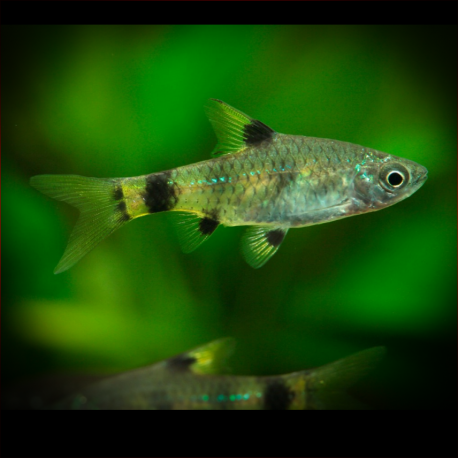More info
Datasheet
| Minimum Tank Size | 60 litres / 15.85 US gallons |
| Maximum Size | 4.0cm / 1.57inches |
| Temperature | 18°C / 64.40°F - 24°C / 75.20°F |
| Hardness | 1.01dgH / 18ppm - 10.03dgH / 179ppm |
| pH | 6.0-7.0 |
General Description
The Golden Dwarf Barb, scientifically known as Pethia Gelius, was formally distinguished from closely-related congener species like P. canius and P. aurea after taxonomic revisions by Knight in 2013. These diminutive cyprinids exhibit a distinct coloration pattern with features such as lateral line scales, fin ray serration, and a combination of black blotches on the body for species differentiation. In captivity, their appearance is vibrant, with males displaying vivid colors when part of a school of 8-10 individuals. This species prefers sluggish, turbid waters alongside other small fish species and shrimp in a densely planted aquarium setup.
Aquarium Setup
Best suited for a densely planted tank with the addition of floating plants and driftwood, the Golden Dwarf Barb thrives in a carefully aquascaped environment. Moderate filtration is recommended given its preference for sluggish waters. Ideal water conditions include a pH range of 6.0-7.0 and temperatures between 18-24°C. A tank size of at least 60 liters is advised, with compatibility with small, peaceful tankmates.
Behaviour
Known for its peaceful demeanor, the Golden Dwarf Barb does best when kept in groups of 8-10 to reduce stress and exhibit its natural schooling behavior. While they tend to be shy, maintaining them in decent numbers encourages optimal coloration and breeding behavior. They are best housed with other diminutive species like Microdevario, Trigonostigma, and freshwater shrimp, fostering a harmonious aquarium community.
Feeding and Diet
In the wild, the Golden Dwarf Barb feeds on small insects, worms, and zooplankton. In captivity, they readily accept a variety of foods, but a diet rich in live and frozen fare like Daphnia and Artemia is recommended for optimal health and coloration. Ensuring a balanced diet of live, frozen, and dried foods is vital to encourage breeding behavior and overall well-being.
Reproduction & Dimorphism
Reproduction in the Golden Dwarf Barb involves egg-scattering free spawning, wherein adults do not provide parental care. Setting up a separate breeding aquarium with suitable conditions, such as dim lighting and fine-leaved plants, can increase fry survival rates. Mature females are distinguishable by their rounder bellies and subdued coloration compared to males, enhancing breeding success.
Habitat and Distribution
Native to the Ganges and Brahmaputra river drainages in India, Nepal, and Bangladesh, the Golden Dwarf Barb typically inhabits sluggish waters with muddy substrates and marginal zones of rivers. Recent records suggest a wider distribution, including regions in southern India and Myanmar. Variations in color patterns and morphology occur based on geographical location, reflecting the adaptability of this species to diverse habitats.

